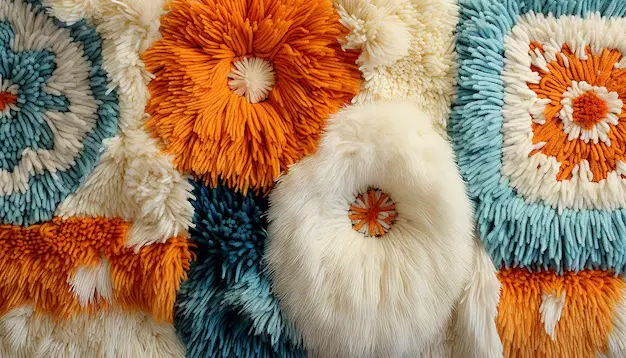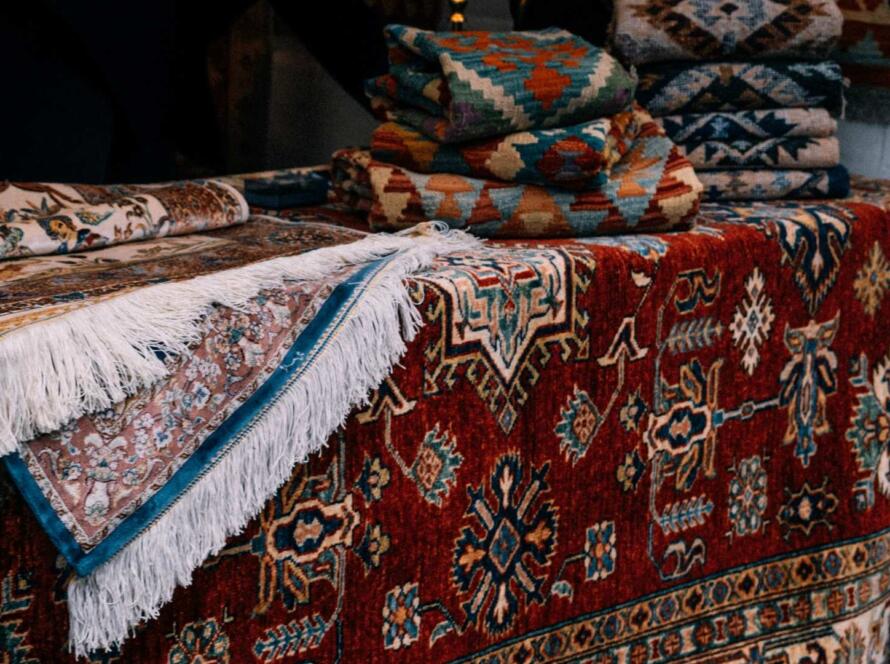Hand knotted carpets offer a unique blend of artistry and durability, making them a standout choice for any home. Investing in a hand knotted carpet not only elevates the aesthetic of a space but also provides exceptional longevity, setting it apart from machine-made alternatives. The intricate craftsmanship involved in creating these carpets results in patterns and textures that are often unmatched, appealing to those who appreciate genuine artistry.
As 2024 trends in rugs continue to emerge, hand knotted designs remain at the forefront for their timeless appeal. Homeowners are increasingly drawn to distinctive pieces that add character and warmth to their interiors. With various styles and materials available, a hand knotted carpet can seamlessly complement different décor themes, enhancing the overall ambiance of a room.
Choosing a hand knotted carpet represents more than just a purchase; it is a commitment to quality and tradition. Their sustainable production methods resonate with modern consumers who prioritize environmentally friendly options. In a world of fast fashion, these rugs provide a lasting solution that not only beautifies a space but tells a story of craftsmanship and heritage.
The Art of Hand Knotted Carpets
Hand knotted carpets are a blend of artistry and craftsmanship, reflecting a rich heritage. Understanding their history, manufacturing process, and how to identify quality can help buyers make informed choices.
History and Tradition of Hand Knotted Carpets
Hand knotted carpets have deep historical roots, particularly in regions such as Persia, India, and Turkey. Their origins can be traced back thousands of years, often used as functional items and symbols of wealth.
Traditionally, these carpets were made by nomadic tribes and artisans, passed down through generations. The motifs and patterns often represent cultural significance, incorporating symbolism or storytelling that reflects the artisans’ heritage.
Materials, techniques, and designs vary across different cultures, adding to the uniqueness of each carpet. While some are simple, others feature intricate designs that require years of skill to master.
Manufacturing Process
The manufacturing process of hand knotted carpets is meticulous and labor-intensive. The craftsmanship typically begins with selecting high-quality materials such as wool, silk, or cotton. These materials influence the durability and feel of the finished product.
Artisans start by creating a warp and weft system, where the warp threads are set up on a loom. The actual knotting process involves tying individual knots around the warp threads, often requiring months or even years to complete a single piece.
After knotting, the carpet goes through a washing and finishing stage, enhancing the colors and textures. This care in production plays a vital role in the quality and longevity of the carpet.
Identifying Quality in Hand Knotted Carpets
To determine the quality of a hand knotted carpet, buyers should consider several key factors. One crucial element is knot density; a higher knot count typically signifies a more durable and intricate design.
Examining materials is essential. Wool tends to be more resilient, while silk offers a luxurious finish. Assessing the design’s fluency and symmetry also indicates craftsmanship quality.
A genuine hand knotted carpet should have imperfections, a testament to its handmade nature. Buyers should be cautious of overly uniform patterns, as they may indicate machine-made products.
Additionally, knowing the carpet’s origin can impact its value, as certain regions are known for superior craftsmanship and unique styles.
Durability and Longevity
Hand-knotted carpets are well-regarded for their durability and longevity. Factors such as materials used and craftsmanship play critical roles in determining how long these rugs can last, often outliving machine-made alternatives.
Materials and Craftsmanship
The quality of materials significantly impacts the durability of hand-knotted carpets. Wool is commonly used for its resilience and natural stain resistance. Silk, while luxurious, is less durable. Additionally, cotton is sometimes used for its softness but may not withstand heavy traffic as well as wool.
Craftsmanship also plays a vital role. Artisans who employ traditional knotting techniques create rugs that can endure for decades or even centuries with proper care. The knot density is crucial; a higher knot count typically indicates a stronger, longer-lasting rug. It is not uncommon for high-quality hand-knotted carpets to last 30 years or more, often being passed down through generations.
What Type of Rugs Last the Longest?
When considering longevity, certain types of rugs outperform others and lasts long. Hand-knotted wool carpets generally top the list due to their durability and ease of maintenance. Persian and Oriental rugs are especially renowned for their ability to withstand wear and tear over time.
In contrast, machine-made rugs usually have a shorter lifespan, often lasting around 5 to 15 years. Synthetic materials, while affordable, tend to wear out quicker. Investing in high-quality materials and timeless designs can provide a lasting foundation for any home or office space.

Design and Aesthetics
Hand-knotted carpets offer a unique blend of craftsmanship and artistic expression. Their designs cater to various tastes, allowing homeowners to find options that complement their interior decor while enhancing the overall aesthetic.
Varieties of Carpet Design 2024
In 2024, carpet design trends showcase a diverse range of styles, from traditional to contemporary. Hand-knotted carpets often feature intricate patterns, vibrant colors, and quality materials, making each piece a work of art.
Popular Styles:
- Persian: Exquisite patterns and rich colors.
- Modern Geometric: Clean lines and minimalistic designs.
- Nature-Inspired: Floral motifs and earthy tones.
These designs can cater to various aesthetics, whether a lavish living room or a cozy study. Homeowners can select patterns that align with their personal style while ensuring durability and timeless appeal.
Selecting the Right Size for Your Space
Choosing the right size rug significantly impacts a room’s design. For a living room, the carpet should ideally encompass the main seating area, allowing all furniture to sit comfortably on it.
Common Sizes:
- 8×10 Feet: Suitable for smaller living rooms.
- 9×12 Feet: Ideal for standard spaces with ample seating.
- 12×15 Feet and More: Great for open-concept areas.
Correct sizing not only enhances visual balance but also creates an inviting atmosphere. Proper placement ensures that the carpet serves both functional and aesthetic purposes, tying the room together seamlessly.
Practical Considerations
When selecting a hand-knotted carpet, it’s important to consider the appropriate grade based on its intended use, along with care and maintenance guidelines. These factors ensure the longevity and aesthetic appeal of the carpet in both residential and commercial spaces.
Best Grade of Carpet for Different Uses
The best grade of carpet varies according to the setting. For home use, medium to high-grade options are recommended. They offer a balance of durability and softness, making them suitable for living spaces and bedrooms.
In contrast, office environments may benefit from commercial-grade carpets, which provide resilience to heavy foot traffic. High-quality tufted rugs, while softer, may not withstand wear as effectively. For those seeking washable options, manufacturers like Shivalika Rugs offer practical solutions that address both style and usability.
Care and Maintenance
Proper care extends the life of a hand-knotted carpet. Regular vacuuming helps to eliminate dirt and prevent damage to fibers. It’s advisable to rotate the carpet periodically to ensure even wear.
Stains should be addressed immediately; blot, do not scrub, to prevent further damage. Professional cleaning is recommended every 1-3 years for deeper maintenance. Avoid harsh chemicals, as they can degrade the fibers. With these practices, the beauty of hand-knotted carpets can be preserved, ensuring they remain a valuable addition to any space.
Market Trends and Consumer Options
The market for hand-knotted carpets is evolving, driven by consumer preferences and innovative production techniques. Understanding current trends and evaluating reliable manufacturers can provide valuable insights for buyers.
Current and Future Trends
Currently, there is a growing appreciation for handmade carpets that combine craftsmanship with sustainability. Consumers are increasingly seeking unique designs that reflect personal style while aligning with ethical production practices.
Popularity of natural materials: Many buyers now prefer rugs made from wool, silk, or organic fibers. These materials not only enhance aesthetic appeal but also contribute to environmental sustainability.
Customization and personalization: Manufacturers are offering bespoke options, enabling customers to tailor colors and patterns to fit their specific home decor. This trend is likely to continue as individual expression becomes more important in interior design.
Evaluating Carpet Wholesalers and Manufacturers
When choosing a carpet wholesaler or manufacturer, it’s essential to consider their reputation and product range. Shivalika Rugs, for instance, operates as a notable carpet wholesaler in India, providing a diverse selection of hand-knotted carpets.
Quality assurance: Look for companies that prioritize craftsmanship and source high-quality Rugs. Businesses like Shivalika are known for their commitment to producing durable, beautiful rugs.
Product variety: Evaluate if manufacturers also offer options like washable rugs or faux fur rugs. Companies like Shivalika Rugs provide various solutions, including hotel carpets and PVC floor carpets, catering to different segments and ensuring diverse consumer needs are met.
Environmental and Ethical Implications
Choosing hand-knotted carpets involves considering their environmental footprint and ethical practices within the industry. These rugs often reflect sustainability and social responsibility, impacting both the planet and the communities that produce them.
Sustainability in Rug Manufacturing
Hand-knotted carpets are typically made from natural fibers such as wool, silk, or cotton. These materials are biodegradable and lessen environmental impact compared to synthetic alternatives.
Manufacturers focusing on sustainability often source their materials responsibly. This includes using dyes derived from plants or other organic components, promoting an eco-friendly production process.
Many artisans also use traditional techniques that consume less energy. This commitment to low-impact methods aligns with increasing consumer demand for sustainable products, ensuring that every carpet contributes positively to the environment.
Social Responsibility in the Carpet Industry
The hand-knotting process supports local artisans and communities. Many skilled weavers hail from regions where craft traditions have been passed down for generations.
Investing in hand-knotted carpets often helps sustain fair labor practices. Workers are typically compensated fairly and given safe working conditions.
Brands committed to ethical production may also support education and healthcare initiatives in weaving communities. This not only uplifts the artisans but also promotes long-term social development.
Ultimately, purchasing a hand-knotted carpet can reflect a commitment to both environmental sustainability and social integrity.
Making the Purchase Decision
Deciding to purchase a hand-knotted carpet involves careful consideration of cost and quality. The value of these rugs often justifies the investment, especially when considering their craftsmanship and longevity.
Balancing Cost with Quality
When purchasing a hand-knotted carpet, it’s essential to balance cost with quality. High-quality hand-knotted rugs often come with a higher price tag due to the labor, materials, and skill involved in their creation.
Buyers should evaluate their budget while also understanding that a well-made rug can last for generations. Opting for a less expensive option may lead to more frequent replacements, resulting in higher costs over time.
When assessing a carpet’s price, consider factors such as:
- Material: Wool or silk rugs typically cost more but offer superior durability.
- Knot Count: Higher knot counts usually signify better quality and detail, affecting the price.
- Origin: Rugs from renowned regions like Persia or India often come at a premium.
The Investment in Hand Knotted Rugs
Purchasing a hand-knotted carpet is more than a mere transaction; it is an investment. These rugs not only enhance the aesthetic of a living space but can also increase in value over time.
Their unique craftsmanship means that each piece is one-of-a-kind. Collectors often seek out specific styles or patterns, further driving value.
Consider the following benefits of investing in hand-knotted rugs:
- Durability: Constructed to withstand wear and tear, making them suitable for high-traffic areas.
- Timelessness: Their classic designs ensure they remain in style, avoiding trends that may fade.
- Cultural Significance: Many hand-knotted rugs carry stories or traditions, adding unique significance to your space.
Being informed about these aspects can help make a more prudent and satisfying purchase decision.




